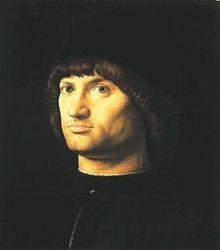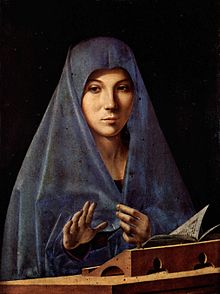- Antonello da Messina
-
Antonello da Messina 
Portrait of a man, called the Condottiero, dated 1475 (Louvre)Birth name Antonello di Giovanni di Antonio Born c. 1430
Messina, ItalyDied February 1479
Messina, ItalyNationality Italian Field Painting Training nothing Movement Italian Renaissance Works St. Jerome in His Study
St. Sebastian
Virgin AnnunciateAntonello da Messina, properly Antonello di Giovanni di Antonio (c. 1430 – February 1479) was an Italian painter from Messina, Sicily, active during the Italian Renaissance. His work shows strong influences from Early Netherlandish painting and, unusually for a painter from Southern Italy, he was influential on the art of Northern Italy, especially Venice.
Contents
Early life
Antonello was born at Messina around 1429-1431, to Giovanni de Antonio Mazonus and Garita (Margherita). He was probably apprenticed both in his native city and in Palermo.
Around the year 1450, according to a 1524 letter of the Neapolitan humanist Pietro Summonte,[1] he was a pupil of the painter Niccolò Colantonio at Naples, at the time one of the most active centres of Renaissance arts.
Around 1455 he painted the so-called Sibiu Crucifixion, which was inspired by the Flemish Calvaries and is housed in the Muzeul de Artǎ in Bucharest. Of the same years is the Crucifixion in the Royal Museum of Antwerp: his early works shows a marked Flemish influence, which it is now understood he derived from his master Colantonio and from works by Rogier van der Weyden and Jan van Eyck that belonged to Colantonio's patron, Alfonso V of Aragon; his biographer Vasari remarked that Antonello saw at Naples an oil painting by Jan Van Eyck (the "Lomellini Tryptych") belonging to King Alfonso V of Aragon; Vasari's further narrative, that being struck by the new method, set out for the Netherlands to acquire a knowledge of the process from Van Eyck's disciples is discredited today. Another theory, supported only by vague documentary evidence, suggests that in 1456 Antonello visited Milan, where he might have met Van Eyck's most accomplished follower, Petrus Christus. Since Antonello was one of the first Italians to master Eyckian oil painting, and Christus was the first Netherlandish painter to learn Italian linear perspective, their meeting is a tempting answer to both questions. But in fact, neither artist is known for certain to have been in Milan at the time.
Career
The following year, Antonello received his first commission as an independent artist, a banner for the Confraternità di San Michele dei Gerbini in Reggio Calabria. At this date, he was already married, and his son Jacobello had been born.
In 1460, his father is mentioned leasing a brigantine to bring back Antonello and his family from Amaltea, a town in Calabria. In that year, Antonello painted the so-called Salting Madonna, in which standard iconography and Flemish style are backed by a greater attention in the volumetric proportions of the figures, probably coming from his knowledge of some works by Piero della Francesca. Also from around 1460 are the two small panels depicting Abraham Served by the Angels and St. Jerome Penitent now in the Museo Nazionale della Magna Grecia in Reggio Calabria. In 1461 his younger brother Giordano entered Antonello's workshop, signing a three-years' contract. Of that year is a Madonna with Child for the Messinese nobleman Giovanni Mirulla, now lost.
Between 1465-1470, Antonello finished a Portrait of a Man now at Cefalù. His portraits are noteworthy for his characteristic use of the three-quarter view, typical of the Flemish School, whereas almost all Italian painters adopted the medal profile pose. Antonello travelled to Venice around 1470, to see Giovanni Bellini's paintings.
In this year he executed his first signed and dated work, the Salvator Mundi. Back at Sicily, Antonello finished the St. Gregory's Polyptych.
In 1474, he painted the Annunciation, now in Syracuse, and the St. Jerome in His Study, one of his most famous paintings. The following year he began his regular sojourn in Venice, where he remained until the fall of 1476. His works of this period begin to show a greater attention to the human figure, regarding both anatomy and expressivity, according to the influence of Piero della Francesca and Bellini.
His most famous pictures dating from this period include the Condottiero (Louvre, illustration), the San Cassiano Altarpiece and the St. Sebastian (see selected works for details). The San Cassiano Altarpiece was especially influential on Venetian painters, as it was one of the first of the large compositions in the sacra conversazione format which was perfected by Giovanni Bellini (Antonello's surviving work in Vienna is only a fragment of the much larger original).
Antonello returned briefly to Sicily in 1476, where he painted the famous Virgin Annunciate, now in the Palazzo Abatellis at Palermo.
Death
He died at Messina in 1479: his testament dates from February of that year, and he is documented as no longer alive two months later. Some of his last works remained unfinished, but were completed by his son Jacobello.
 Crucifixion, Antwerp, detail.
Crucifixion, Antwerp, detail.
Style and legacy
Antonello's style is remarkable for its union, not always successful, of Italian simplicity with Flemish concern for detail. He exercised an enormous influence on Italian painting, not only by the introduction of the Flemish invention, but also by the transmission of Flemish tendencies. However, no school of painting formed after his death, with the exception of the Sicilian Marco Costanzo.
Selected works
- Sibiu Crucifixion (1455) - Muzeul de Artà, Bucharest
- Crucifixion (1455) - Oil on panel 52.5 x 42.5 cm, Koninklijk Museum voor Schone Kunsten, Antwerp
- Abraham Served by the Angels - Museo della Magna Grecia, Reggio Calabria
- Ecce Homo (c. 1470) - Tempera and oil on panel, 42.5 x 30.5 cm, Metropolitan Museum of Art, New York City
- Ecce Homo (1470) - Tempera and oil on panel, 40 x 33 cm, Galleria Nazionale di Palazzo Spinola, Genoa
- St. Jerome Penitent - Various techniques on wood, 40.2 x 30.2 cm, Museo della Magna Grecia, Reggio Calabria
- Ecce Homo (c. 1473) - Tempera on panel, 19.5 x 14.3 cm, Private collection, New York City
- Portrait of a Man (1474) - Oil on wood, Staatliche Museen, Berlin
- Madonna with Child (Salting Madonna) - Oil on wood, 43.2 x 34.3 cm, National Gallery, London
- Portrait of a Man (1474) - Oil on wood, 32 x 26 cm, Staatliche Museen, Berlin
- Annunciation (1474) - Oil on panel, 180 x 180 cm, Museum of Palazzo Bellomo, Syracuse
- St Jerome in His Study (c. 1474) - Oil on wood, 46 x 36,5 cm, National Gallery, London
- Ecce Homo (1475) - Oil on panel, 48.5 x 38 cm, Collegio Alberoni, Piacenza
- Portrait of a Man (Il Condottiere) (1475) - Oil on wood, 35 x 38 cm, Musée du Louvre, Paris
- Crucifixion (1475) - Wood, 42 x 25,5 cm, National Gallery, London
- Portrait of a Man (c. 1475) - Oil on wood, Galleria Borghese, Rome
- Portrait of a Man (c. 1475) - Oil on panel, 36 x 25 cm, National Gallery, London
- Portrait of a Man (1475–1476) - Oil on panel, 28 x 21 cm, Museo Thyssen-Bornemisza, Madrid
- San Cassiano Altarpiece (1475–76) - Oil on panel, Kunsthistorisches Museum, Vienna
- The Dead Christ Supported by an Angel (1475–78) - Panel, 74 x 51 cm, Museo del Prado, Madrid
- Christ at the Column (c. 1475-1479) - Oil on wood, 25,8 x 21 cm, Musée du Louvre, Paris
- Virgin of the Annunciation -Oil on panel, Alte Pinakothek, Munich
- Portrait of a Man (1476) - Oil on panel, Museo Civico d'Arte Antica, Turin
- Virgin Annunciate (c. 1476) - Oil on wood, 45 x 34,5 cm, Museo Nazionale, Palermo
- St. Sebastian (1477–1479) - Oil on canvas transferred on table, 171 × 85 cm, Gemäldegalerie Alte Meister, Dresden
- Portrait of a Young Man (c. 1478) - Panel, 20.4 x 14.5 cm, Staatliche Museeun, Berlin
Notes
- ^ The letter to the Venetian Marcantonio Michiel, of 20 March 1524, reporting on the state of art in Naples, and works there by Netherlandish painters, dwells upon Colantonio and his Netherlandish technique, which one sees assimilated in the art of Antonello; it was published by Fausto Niccolini, L'arte napoletana del Rinascimento (Naples) 1925:161-63. It is translated in Carol M. Richardson, Kim Woods and Michael W. Franklin, Renaissance Art Reconsidered: An Anthology of Primary Sources (2007:193-96).
References
 This article incorporates text from a publication now in the public domain: Chisholm, Hugh, ed (1911). Encyclopædia Britannica (11th ed.). Cambridge University Press.
This article incorporates text from a publication now in the public domain: Chisholm, Hugh, ed (1911). Encyclopædia Britannica (11th ed.). Cambridge University Press.
External links
- Antonello da Messina in the "History of Art"
- Antonello da Messina - Biography and Works
- Guardian article on "Portrait of a Man"
- Best of Sicily Magazine article on Antonello da Messina and the technique of egg tempera / oil media
 "Antonello da Messina". Catholic Encyclopedia. New York: Robert Appleton Company. 1913.
"Antonello da Messina". Catholic Encyclopedia. New York: Robert Appleton Company. 1913.
 This article incorporates text from a publication now in the public domain: Herbermann, Charles, ed (1913). Catholic Encyclopedia. Robert Appleton Company.Categories:
This article incorporates text from a publication now in the public domain: Herbermann, Charles, ed (1913). Catholic Encyclopedia. Robert Appleton Company.Categories:- 1430s births
- 1479 deaths
- People from Messina
- Italian painters
- Renaissance painters
- Portrait artists
- Sicilian painters
Wikimedia Foundation. 2010.

